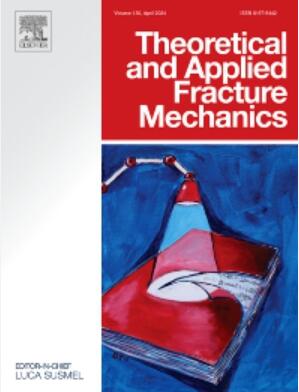热-酸条件下红砂岩I+Ⅱ混合模式裂缝特性研究
IF 5.6
2区 工程技术
Q1 ENGINEERING, MECHANICAL
引用次数: 0
摘要
本研究旨在探讨不同温度(25℃、60℃)、pH值(1,3)条件下硫酸溶液对砂岩力学性能的影响及变质机理。通过系统分析,圈定了不同处理条件下砂岩的表观变化特征,深入探讨了砂岩内部峰值荷载的演化规律和断裂韧性的恶化程度。采用数字图像相关(DIC)技术确定了砂岩裂缝过程带的长度,并与理论值进行了对比分析。同时,将理论值与DIC实测数据相结合,对砂岩试样的起裂角进行了有效预测,并采用GMTS准则提高了预测精度。通过x射线衍射(XRD)分析,揭示了砂岩的矿物组成,探讨了可能发生的化学反应及其变质机理。利用核磁共振(NMR)技术,从微观角度详细分析了砂岩的变质程度。研究结果表明:砂岩表面形成白色物质,峰值载荷和断裂韧性显著降低;不同处理条件下,砂岩裂缝过程带长度存在差异;利用Schmidt模型计算的GMTS准则可以预测砂岩井的起裂角;砂岩内部孔隙结构发生变化,大孔隙比例增加,总孔隙度呈上升趋势。本文章由计算机程序翻译,如有差异,请以英文原文为准。
Study on mixed-mode I+Ⅱ fracture properties of red sandstone under thermal-acid conditions
This study aims to explore the influence of sulfuric acid solution under different conditions of temperature (25 °C, 60 °C) and pH value (1, 3) on the mechanical properties and deterioration mechanism of sandstone. The apparent change characteristics of sandstone under diverse treatment conditions were delineated through systematic analysis, and a thorough exploration was conducted into the evolution patterns of peak load and the degree of deterioration in fracture toughness within the sandstone. The digital image correlation (DIC) technique was employed to determine the length of the fracture process zone in sandstone, followed by a comparative analysis with the theoretical value. Meanwhile, by combining the theoretical values and the DIC measurement data, the fracture initiation angle of the sandstone specimens was effectively predicted, and the GMTS criterion was adopted to improve the prediction accuracy. Through X-ray diffraction (XRD) analysis, the mineral composition of sandstone was revealed, and the possible chemical reactions and their deterioration mechanisms were discussed. Further, the deterioration degree of sandstone was analyzed in detail from a microscopic perspective using nuclear magnetic resonance (NMR) technology. The research results show that white substances formed on the surface of sandstone, and its peak load and fracture toughness significantly decreased; under different treatment conditions, there are differences in the length of the fracture process zone of sandstone; the GMTS criterion calculated using the Schmidt model can predict the fracture initiation angle of sandstone well; the internal pore structure of sandstone changed, with the proportion of macropores increasing, and the total porosity showing an upward trend.
求助全文
通过发布文献求助,成功后即可免费获取论文全文。
去求助
来源期刊

Theoretical and Applied Fracture Mechanics
工程技术-工程:机械
CiteScore
8.40
自引率
18.90%
发文量
435
审稿时长
37 days
期刊介绍:
Theoretical and Applied Fracture Mechanics'' aims & scopes have been re-designed to cover both the theoretical, applied, and numerical aspects associated with those cracking related phenomena taking place, at a micro-, meso-, and macroscopic level, in materials/components/structures of any kind.
The journal aims to cover the cracking/mechanical behaviour of materials/components/structures in those situations involving both time-independent and time-dependent system of external forces/moments (such as, for instance, quasi-static, impulsive, impact, blasting, creep, contact, and fatigue loading). Since, under the above circumstances, the mechanical behaviour of cracked materials/components/structures is also affected by the environmental conditions, the journal would consider also those theoretical/experimental research works investigating the effect of external variables such as, for instance, the effect of corrosive environments as well as of high/low-temperature.
 求助内容:
求助内容: 应助结果提醒方式:
应助结果提醒方式:


